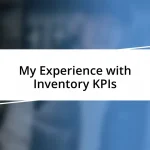Key takeaways:
- Accurate demand forecasting is crucial for effective supply chain management, ensuring optimized inventory levels and increased customer satisfaction.
- Tools like SAP Integrated Business Planning and machine learning algorithms enhance forecasting precision by analyzing various data sources.
- Data collection techniques, such as customer surveys and social media analysis, provide valuable insights for predicting future demand.
- Implementing forecasting models requires balancing data analysis with intuition and fostering collaboration across departments for improved accuracy.
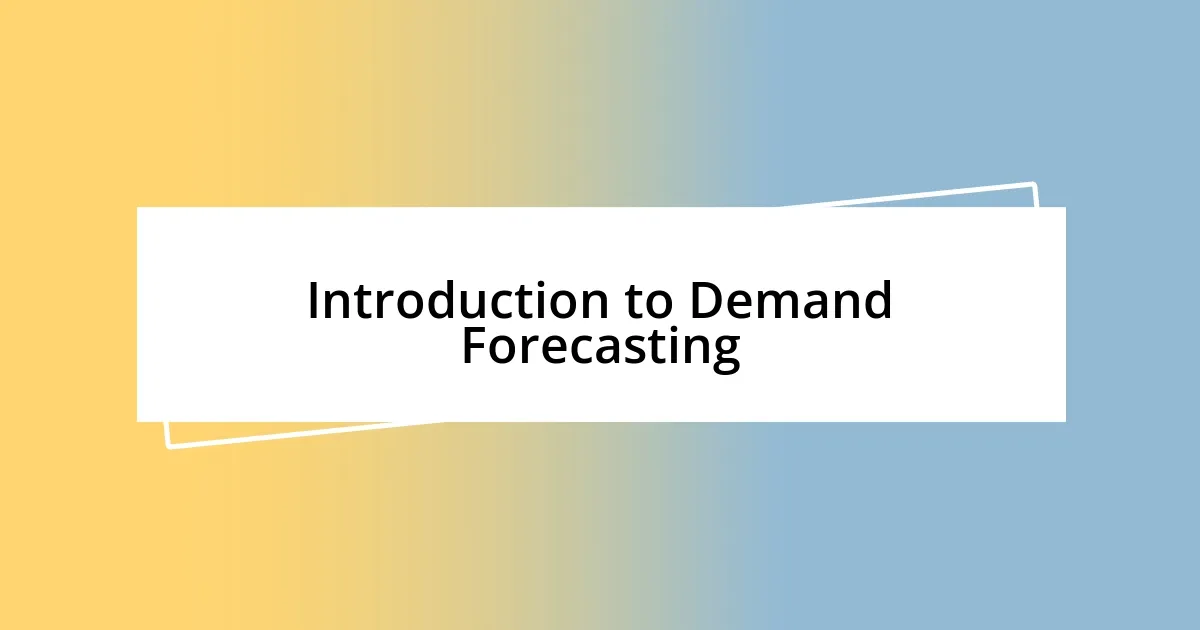
Introduction to Demand Forecasting
Demand forecasting is an essential practice that helps businesses predict future customer needs. I remember when I first encountered it during a busy retail season—our team seemed overwhelmed by erratic sales trends. It struck me how critical accurate forecasting is; it can mean the difference between stock shortages and surplus inventory.
Have you ever wondered why some companies seem to have their products perfectly aligned with market demand? All of us have experienced the frustration of finding shelves empty of our favorite items. This is precisely why understanding demand forecasting is so vital. It involves analyzing historical sales data, market trends, and even customer behavior to gain insights into future demands.
In my experience, the journey of mastering demand forecasting is akin to solving a complex puzzle. Each piece—like economic indicators or seasonal changes—adds depth to our understanding of the market landscape. It’s an engaging process that not only helps businesses thrive but also provides a sense of accomplishment when forecasts align with actual sales.
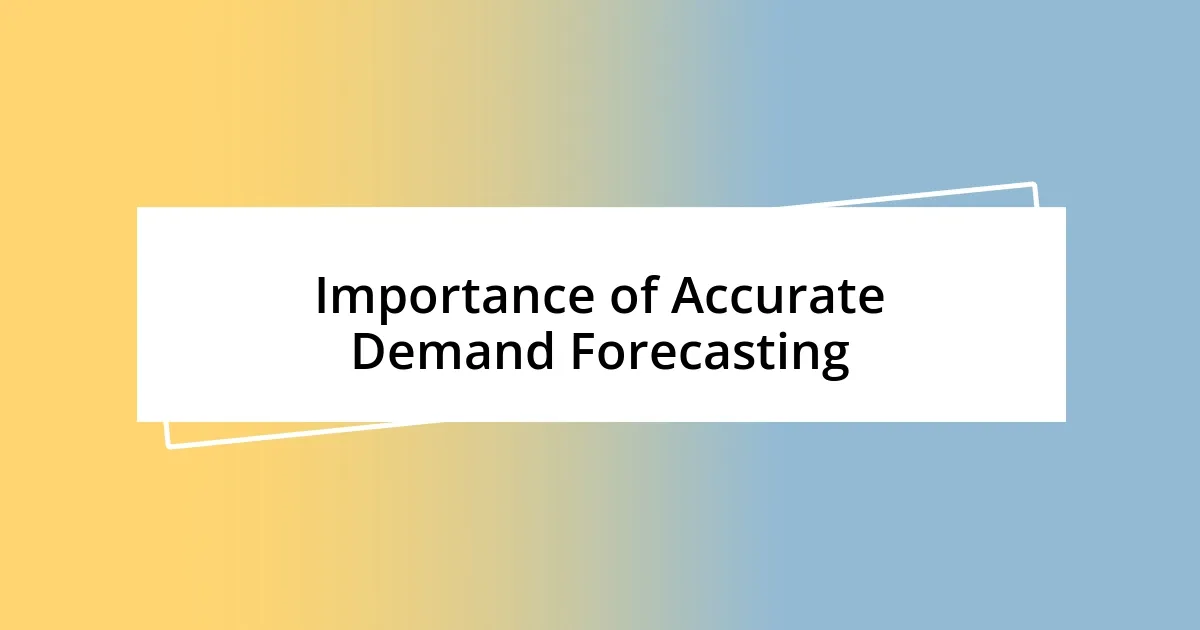
Importance of Accurate Demand Forecasting
Accurate demand forecasting serves as the backbone of efficient supply chain management. I remember a time when our team miscalculated demand for a particular product, leading to an overwhelming surplus of unsold stock. The stress of not being able to move inventory took a toll on our resources and morale. A precise forecast can help avoid such pitfalls and create a smoother operational flow.
The benefits of accurate demand forecasting can be summarized as follows:
- Optimized Inventory Levels: Reduces the risk of overstock and stockouts, ensuring products are readily available when customers want them.
- Cost Efficiency: Helps in managing storage and holding costs by aligning inventory with expected demand.
- Increased Customer Satisfaction: Ensures a better shopping experience by meeting customer expectations, thus fostering loyalty.
- Strategic Planning: Aids in making informed decisions about marketing initiatives or product launches based on predicted market needs.
- Competitive Advantage: Empowering businesses to react proactively to market dynamics, staying ahead of their competition.
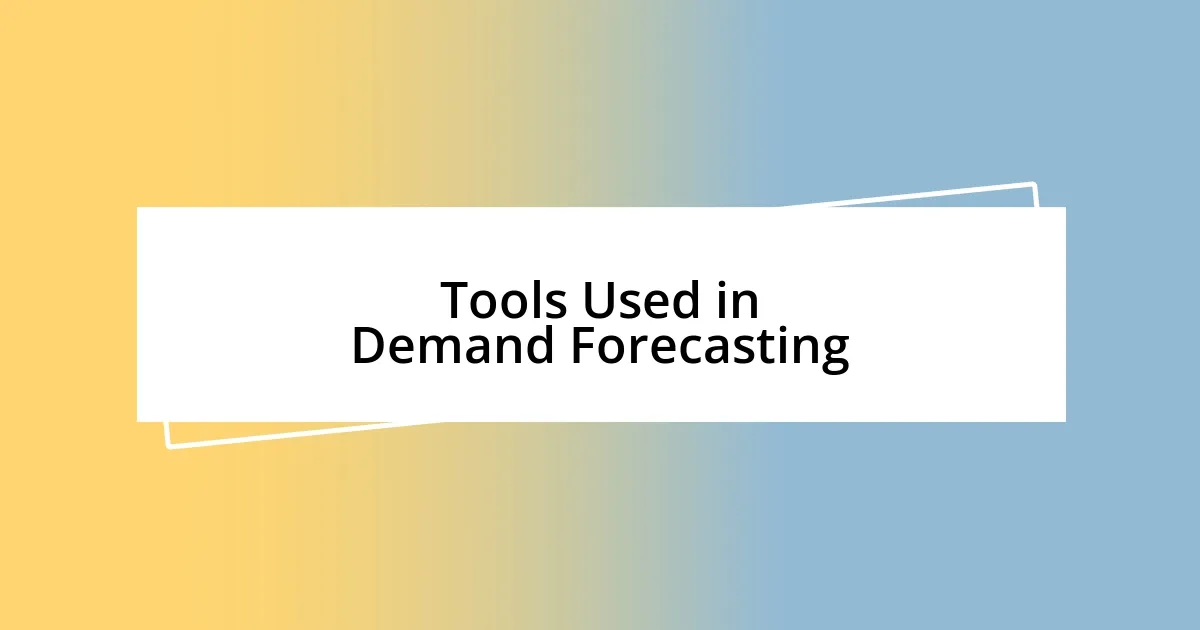
Tools Used in Demand Forecasting
When it comes to demand forecasting, the tools I’ve used have significantly shaped my approach to understanding market trends. For instance, I’ve worked with software like SAP Integrated Business Planning (IBP), which integrates various data points to deliver insights on future demand with remarkable accuracy. I can’t tell you how much I appreciated having a centralized platform to analyze everything from historical sales figures to external economic indicators.
Another tool that I found incredibly valuable is Microsoft Excel. While it may seem basic, the flexibility of Excel allowed me to create tailored forecasting models that aligned perfectly with our specific product lines. I vividly recall spending late nights tweaking algorithms and formulas to refine our predictions, which ultimately paid off during peak seasons when every single item was moving off the shelves briskly.
Lastly, machine learning algorithms have become increasingly prevalent in demand forecasting, and I’ve been excited to see their impact on predictions. These algorithms analyze vast datasets at lightning speed, uncovering patterns that human analysts might overlook. The first time I experienced a significant increase in forecasting accuracy due to machine learning, it felt like witnessing a small miracle in action.
| Tool | Description |
|---|---|
| SAP Integrated Business Planning (IBP) | A comprehensive platform that unifies data from various sources to improve demand forecasting accuracy. |
| Microsoft Excel | A versatile tool for creating customized forecasting models, ideal for analyzing specific product lines. |
| Machine Learning Algorithms | Advanced technology that analyzes large datasets quickly to identify trends and enhance forecasting precision. |
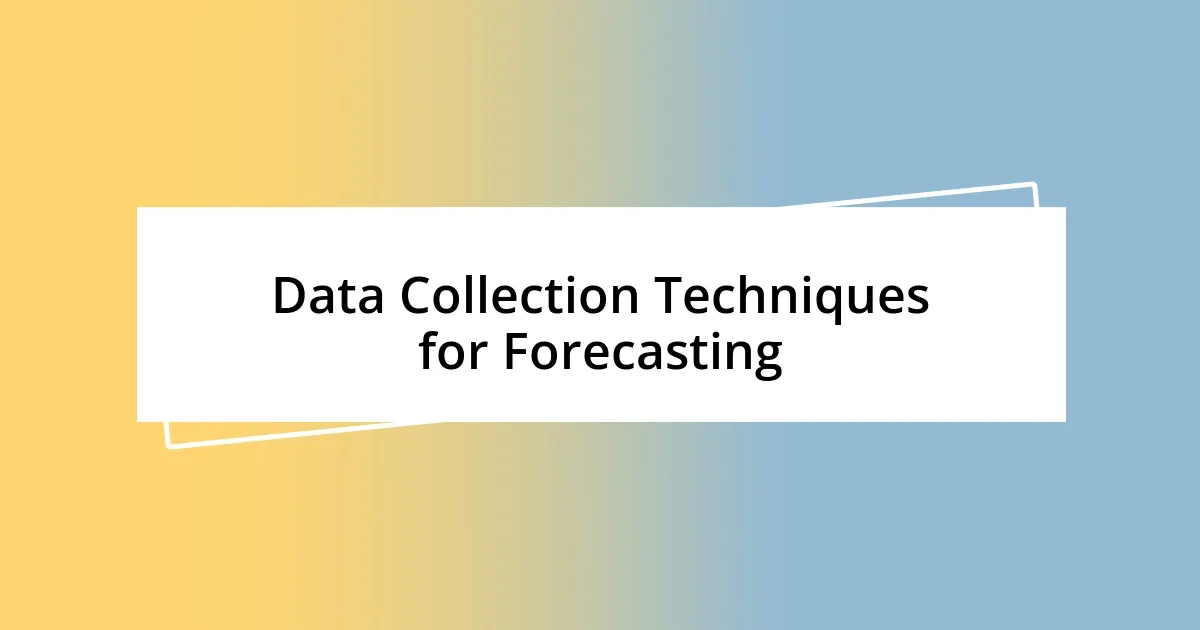
Data Collection Techniques for Forecasting
When it comes to data collection for forecasting, I’ve found that the method you choose can truly make or break your predictions. One effective approach I’ve employed is surveys and customer feedback. It was a game-changer when we decided to directly ask our customers about their preferences and future purchasing intentions. The insights gained were invaluable, making me wonder how much better our forecasts could have been had we done this earlier.
Another technique worth mentioning is analyzing social media trends. I remember when I stumbled upon Twitter chatter about a new product. It sparked my curiosity, leading our team to tap into this online buzz as a real-time indicator of demand. Seeing those discussions unfold in the digital realm helped us pivot our strategies almost on the fly, which was exhilarating. Don’t you think leveraging such immediate platforms could revolutionize forecasting?
Lastly, I can’t overlook historical sales data. Analyzing patterns in past sales has provided me with a solid foundation for predicting future demand. One particular period where we experienced unusual spikes made me realize the importance of not just looking at averages but also understanding anomalies. It’s these past lessons that guide our current decisions. How often do we truly reflect on what history can teach us?
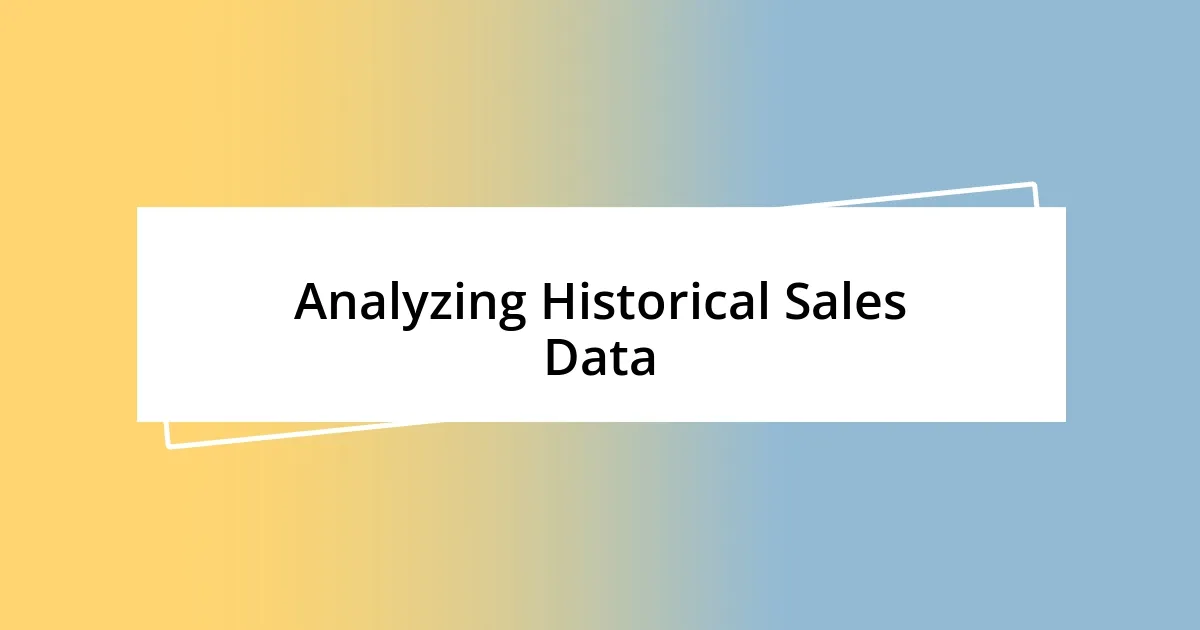
Analyzing Historical Sales Data
One of the most enlightening aspects of analyzing historical sales data is recognizing the stories hidden within the numbers. I remember sifting through monthly sales reports, closely observing fluctuations around holidays. Seeing how our sales spiked during certain festive seasons not only confirmed my expectations but also sparked ideas for tailored promotions. Have you experienced that moment when data transforms into potential growth strategies? It’s quite remarkable.
Digging deeper into specific product performance was equally rewarding. For instance, I noticed that one particular item consistently sold well during the summer months while others struggled. This realization pushed me to think creatively about seasonal marketing tactics. It was a fulfilling experience, pushing me to experiment with limited-time offers that directly aligned with those patterns. Can you feel the thrill of turning data insights into actionable strategies?
Moreover, diving into year-over-year comparisons has proven to be invaluable. I distinctly recall analyzing a decline in sales figures for a product line and quickly identifying the need for a redesign based on customer feedback from previous years. This deep dive not only informed our inventory decisions but also inspired our team to innovate. Reflecting on the lessons from past performance truly helps in crafting a clearer vision for future demands. Have you ever looked back and realized the power of hindsight in shaping your approach? It’s a powerful tool I can’t recommend enough.
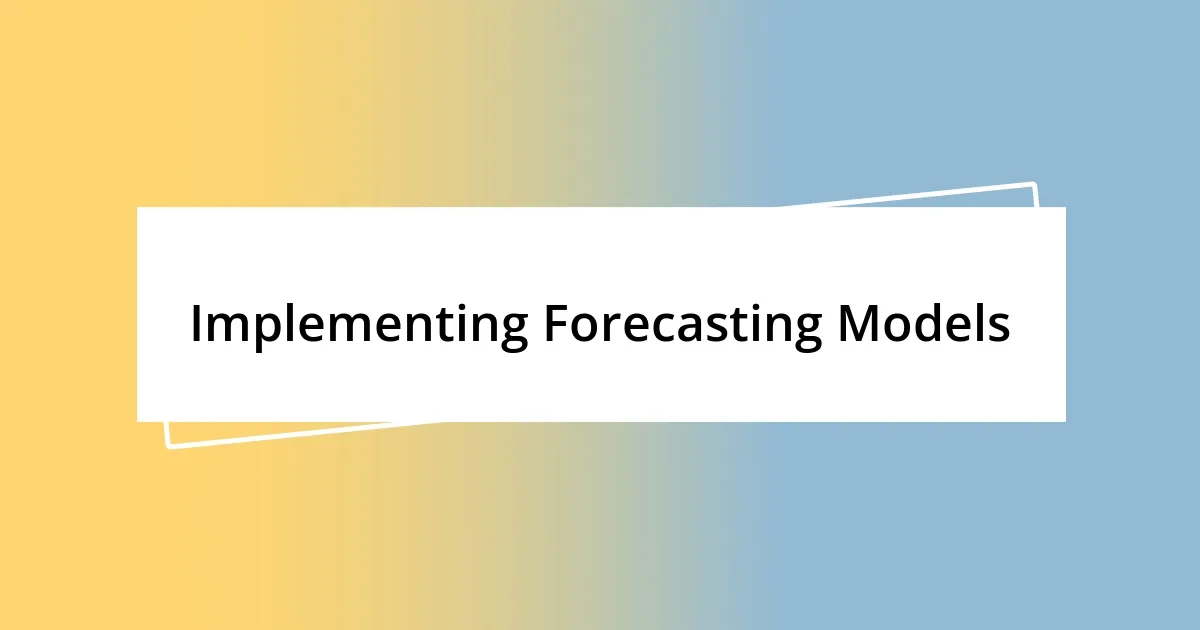
Implementing Forecasting Models
Implementing forecasting models requires a delicate balance of data analysis and intuition. I recall the first time we integrated a quantitative model into our forecasting process. It was both thrilling and intimidating, as we had to choose between various methods like time series analysis and machine learning algorithms. I remember feeling a mix of excitement and trepidation, wondering if we could accurately predict demand in an ever-changing market. Don’t you think finding the right model feels a bit like trying on shoes—some fit beautifully, while others are just not meant for you?
Once we settled on a model, the real fun began with calibration. Adjusting parameters to find the sweet spot was like fine-tuning an instrument. I’ll never forget when I observed a significant drop in forecast accuracy after a key parameter was slightly off. It really struck me how a minor tweak can lead to profound changes in outcomes. Have you found that small adjustments can create such ripple effects in your own processes?
Collaboration also plays a crucial role in implementing these models. I vividly remember our cross-departmental meetings, where sales teams brought insights from the front lines that transformed our projections. The discussions often felt electric, charged with creativity as everyone threw out innovative ideas on how to improve our forecasts. It made me grateful for those conversations, reminding me how vital it is to merge diverse viewpoints to reach common goals. What about you—has team input ever opened up new dimensions in your forecasting efforts?














